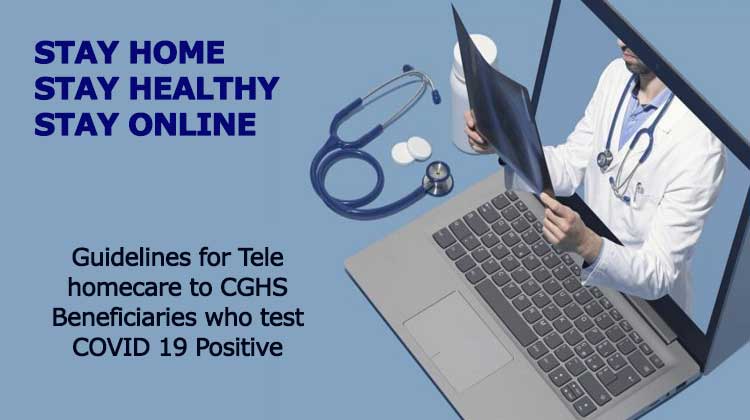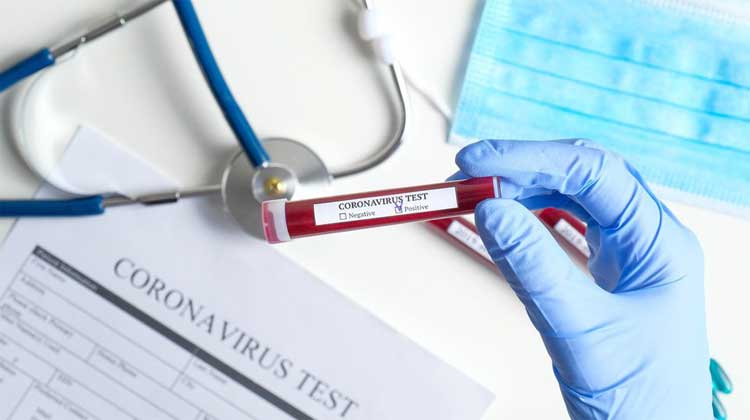
In the case of CGHS beneficiaries, those persons who have been tested positive for Covid-19, have no co-morbidities and decide to opt for home isolation, can access tele-consultation from their Wellness Centre for tele homecare for which the present Guidelines is being issued
F. No. 1-2/2020/CGHS/ADHQ/29
Government of India
Ministry of Health & Family Welfare
Directorate General of CGHS
Nirman Bhawan, New Delhi
Dated the 16th June, 2020
OFFICE MEMORANDUM
Guidelines for Tele homecare of COVID-19 patients
In view of the current Coronavirus Disease (COVID-1 9) Pandemic. the matter relating to providing tele-home care to those CGHS beneficiaries who test positive for COVID 19, manifest mild to moderate symptoms, have no co-morbidities and decide to opt for home isolation has been considered by the CGHS Directorate and it has been decided to issue the attached Advisory for the guidance of patients. caregivers, CGHS doctors and staff.
Additional Directors of Cities/Zones are requested to implement the Advisory, circulate it among all stakeholders, take appropriate action and keep this Directorate informed from time to time.
(Dr. Sanjay Jain)
Director, CGHS
CGHS Advisory for Tele Homecare of COVID 19 Patients
F. No. 1-2/2020/CGHS/ADHQ/29
Government of India
Ministry of Health & Family Welfare
Directorate General of CGHS
ADVISORY FOR TELE-HOMECARE OF COVID 19 PATIENTS
Coronavirus disease (COVID-19) is an infectious disease caused by a newly discovered coronavirus. In majority of people COV1D-19 virus causes mild to moderate respiratory illness and they recover without requiring special treatment. Older people and those with underlying medical problems like cardiovascular disease, diabetes, chronic respiratory disease and cancer may develop serious illness. MoHFW has issued guidelines for home isolation of very mild/pre-symptomatic COVID – 19 cases. The same can be accessed at the following url:
In the case of CGHS beneficiaries, those persons who have been tested positive for Covid-19, manifest mild to moderate symptoms, have no co-morbidities and decide to opt for home isolation, can access tele-consultation from their Wellness Centre for which the present advisory is being issued.
Criteria for Home isolation of Mild/ asymptomatic COVID 19 cases
Home care can be provided to a COVID-19 patient if, advised as such by a doctor for a mild/ asymptomatic patient, by following the given instructions.
i. The patient should not be suffering from any Co-morbid illness like Hypertension or any other cardio-vascular disease, Diabetes, Chronic Asthma /COPD, Malignancy. Kidney diseases. Cerebra-vascular disease, on Immunosuppressant treatment etc..
ii. A caregiver should be available to provide care on 24 x7 basis.
iii. Patient / Caregiver must keep monitoring their health,
iv. A communication link between the caregiver/patient and a healthcare facility is essential for the entire duration of home isolation.
v. The family members of the patient shall observe isolation protocol strictly like wearing the face-mask all the time, the patient should have separate utensils & toilet facility for the duration of home isolation.
vi. The children & elderly in the family shall not come in contact with the patient.
Role of CMO I/C of the CGHS Wellness Centre in Tele- Homecare of COVID 19 positive patients.
The CGHS Wellness Centers provide comprehensive medical care to the beneficiaries, and the COVID 19 is no exception. The fever clinics are already operational in the CGHS Wellness Centres (WC) and the doctors and staff are engaged in fighting COVID 19 cases. Most people infected with the COVID-19 virus experience mild to moderate respiratory illness and recover without requiring special treatment. In view of this, the following guidelines are being issued for the CMOI/C in helping them to render the care through tele-consultation:
Must Read this Article : CGHS Provides 24 x 7 tele-homecare to COVID-19 cases
i. The CMO I/C is the nodal officer for monitoring the tele-homecare to COVID-19 cases under his/her jurisdiction. He /She shall be personally responsible for the same.
ii. The CMOI/C may designate any other Medical Officer of the VVC, who would look after the work in his /her absence.
iii. As soon as the call is received from a COVID 19 positive CGHS beneficiary, his/her particulars as shown in the chart at Annexure I will be entered in a register. Alternatively, the database may be maintained in the computer on excel sheet or MS word table. The patient may also be requested to maintain a similar chart at his end. The format of the chart can be shared with the patient by the CMO I/C through WhatsApp or e-mail.
iv. Through CGHS OM No F.No, 1-2/2020/CGHS/ADHQ/29 dated the 16th June 2020 CGHS patients who have been tested Covid-19 positive have been allowed to purchase one Pulse Oximeter per family as per the condition prescribed therein. CMOI/c or the designated MO will guide such beneficiaries for its use, through a video or on telephone call. The patient is also to be guided on recording of body temperature, urine output. respiratory rate, pulse rate and Oxygen Saturation as per pulse oximeter reading.
v. The patient shall be guided to record all the parameters on the prescribed chart every morning, evening till he/she remains on home isolation and Tele-Homecare for COVID 19 illness.
vi. It will be the duty of the CMOI/c or the designated Medical Officer to call such beneficiary on the registered mobile phone in the morning at a specified time and to fill up all the stipulated parameters in the chart.
vii. The information in r/o the status of illness is to be shared by the CMOI/C on e-mail with the Additional Director of his/her zone or city on daily basis.
viii.The CMOI/C shall advise the patients regarding use of paracetamol etc., for symptomatic treatment.
ix. The patients are also to be sensitized for warning symptoms as enumerated below:
a. Difficulty in breathing, or shortness of breath observed while walking within the room
b. Inability to complete sentences without being short of breath
c. Persistent pain, heaviness or pressure in the chest
d. Mental confusion or inability to arouse
e. Having weakness or numbness in any arm, leg or face
f. Slurred speech or seizures
g. Bluish discoloration of lips/face.
Overall, the CMOI/C / designated MO will be guided by MoHFVV’s guidelines on home isolation referred above.
Role of CGHS Beneficiary / COVID 19 Patient :
The beneficiaries are advised to observe the golden principles of preventing the disease by hand sanitization. wearing face cover/mask and social distancing. Apart from these golden principles the beneficiaries are expected to report early when sick and also report the matter whenever they come in contact with any known case of COVID 19 to their CGHS wellness Centre, They are also advised to download Arogya Setu App and self-monitor their health status.
They are also advised to remain in regular contact with the CMOI/C of their Wellness Centre for any health assistance. In case a beneficiary is tested COVID 19 positive, he/she will report the matter to the CMO I/C of the Wellness Centre, who will take action as detailed above.
For availing Tele-Horne Care, the CGHS beneficiaries are required to submit their consent, preferably through the consent form. However, in case of difficulties being faced in sending the form physically the consent can be given through WhatsApp/ e¬mail.
The patient/caregiver will fill up the chart daily as per the guidance received from the CMOI/C/ designated MO and share the parameters with CMOI/C over telephone. In majority of mild/ asymptomatic cases there may not be any need for hospitalization. In such cases, the guidance received from the CMOI/C may be followed. However, the moment the patient notices any of the symptoms or exacerbation of the same (as indicated in the segment warning signs of this Advisory) he/she will immediately contact the CMOI/C who in turn would take appropriate action.
Selecting an Isolation Room
i. Patient to be isolated in a separate clean room of the house, with good ventilation.
ii. Room preferably should have an attached toilet and washroom.
iii. This room must not be shared by any other COVID-19 negative person.
iv. Patient must stay in this specific room and away from other family members or pets for the complete isolation duration.
Instructions for caregivers for COVID 19 patient
Family Member or any other person taking care of COVID 19 patient shall become the Caregiver. He/She shall follow the guidelines given under;
Mask hygiene
i. The caregiver should wear a triple layer medical mask appropriately when in the same room with the ill person/ asymptomatic COVID case.
ii. Front portion of the mask should not be touched or handled during use.
iii If the mask gets wet or dirty with secretions. it must be changed immediately. Discard the mask after use and perform hand hygiene after disposal of the mask.
Hand hygiene
i. Hand hygiene must be ensured following contact with ill person or his immediate environment.
ii. He/she should avoid touching own face, nose, or mouth with unclean hands.
iii. Hand hygiene should also be practiced before and after preparing food, before eating, after using the toilet, and whenever hands look dirty.
iv. Use soap and water for hand washing at least for 40 seconds.
v. Alcohol-based hand rub can be used if hands are not visibly soiled.
vi. After using soap and water, use of disposable paper towels to dry hands is desirable. If not available, use dedicated clean cloth towels and replace them when they become wet.
Exposure to patient
i. Avoid direct contact with body fluids of the patient, particularly oral or respiratory secretions. Use disposable gloves while handling the patient.
ii. Perform hand hygiene before putting on and after removing gloves.
Exposure to the patient’s environment
i. Avoid exposure to potentially contaminated items in his immediate environment (e.g. avoid sharing cigarettes, eating utensils, dishes, drinks, used towels or bed linen).
ii.Food must be provided to the patient in his/her room
iii. Utensils and dishes used by the patient should be cleaned with soap/detergent and water wearing gloves.
iv. The utensils and dishes may be re-used after thorough washing.
v. Clean hands after taking off gloves or handling used items.
vi. Use triple layer medical mask and disposable gloves while cleaning or handling surfaces, clothing or linen used by the patient.
vii. Perform hand hygiene before and after removing gloves.
The care giver will make sure that the patient follows the prescribed treatment.
The caregiver and all close contacts will self-monitor their health with daily temperature monitoring. Oxygen saturation and report promptly to CMG liC of their CGHS Wellness Centre, if they develop any symptom suggestive of COVID-19 (fever/cough/ sore throat/ running nose/ difficulty in breathing)
Instructions for the COVID 19 patient
Mask hygiene
i. Patient should always use triple layer medical mask.
ii Discard mask after 24 hours of use or earlier if they become wet or visibly soiled.
iii. Mask should be discarded only after disinfecting it with household bleach (prepared as per the manufacturer’s instructions).
Hand hygiene
i. Hands must be washed often with soap and water for at least 40 seconds
ii. Use an alcohol-based hand sanitizer with at least 60% alcohol, for cleaning hands when not visibly dirty
iii. Hands must be cleaned after blowing nose, coughing, or sneezing: going to the bathroom; and before eating or preparing food.
Cough etiquettes
i. Cover the mouth and nose with a tissue on coughing or sneezing.
ii. Throw away used tissues in a lined trash can.
iii. Immediately wash your hands with soap and water for at least 20 seconds.
iv. If soap and water are not available, clean your hands with an alcohol-based hand sanitizer.
Important Precautions
i. Patient must stay in the identified room and away from other people in home, especially elderlies and those with co-morbid conditions like diabetes, hypertension, cardiovascular disease, renal disease. cancer etc.
ii. Do not share personal items with other people.
iii. Clean surfaces in the room that are touched often (tabletops, doorknobs, handles, etc.) with household bleach (prepared as per the manufacturer’s instructions) or detergent.
iv. The patient must strictly follow the physician’s instructions and medication advice.
v. Patient must take rest and drink lot of fluids to maintain adequate hydration
vi. The patient will self-monitor his/her health with daily temperature monitoring and report promptly if develops any deterioration of symptom as detailed below.
vii. All the generated disposable items like masks and gloves that are infected must be soaked in a disinfectant (like the house hold bleach) solution before discarding.
Monitoring Vital Health Record
The primary responsibility of the patient and the care giver is to maintain the health records in respect of Pulse Rate Per Minute, Temperature in degree Celsius C), Sp02 in percentage and urine output in 24 hours, these are to be recorded in duly prescribed table and to be shared by the CMOI/C of the CGHS Wellness Centre. This is basically a history sheet monitoring the progress of the illness objectively. The same is to be shared with the CMOI/C of the CGHS VVellness Centre on daily basis. A call will come from the CMOI/C of the wellness Centre of patient (where he is registered/designated Wellness Centre) to monitor the progress of illness and guide for future course of treatment.
How to measure temperature (if possible): Measure the temperature using a thermometer below the tongue for 1 min. and properly clean before and after use every time. Keep a record of temperature on the prescribed sheet with date and time.
How to measure respiratory rate ( if possible) : Keep your hand over the abdomen and see for the hand movement up and down along with normal breathing. Count it for 1 minute. It is better to be examined by the care giver without making the patient aware of it, so that the respiratory rate is estimated correctly. The rate so measured must be entered in the prescribed sheet with date and time.
Intake /output (if possible): Measure how much water is being taken per day. Also note down how much times and an approximate volume of urine passed over a period of 24 hours.
Oxygen Saturation (SpO2) Pulse Oximeter Probe is to be put in a finger with nail upward and nail bed touching the inside of probe. A video may be shared by the CMOI/C of the CGHS Wellness Center for the convenience of the caregiver and patient preferably on VVhatsApp, the videos are also available in You tube. SpO2 and pulse may also be monitored twice a day, by inserting a finger in the probe.
The readings of the Sp02 must be recorded on the prescribed sheet and shared with the CMOIC of the CGHS Wellness Centre.
Patient themselves or a caregiver must keep monitoring their health to look for any
WARNING SIGNS
Immediate medical attention must be sought if any of the warning signs or symptoms develop. These include:
i. Difficulty in breathing, or shortness of breath observed while walking within the room
ii. Inability to complete sentences without being short of breath
iii. Persistent pain, heaviness or pressure in the chest
iv. Mental confusion or inability to arouse
v. Having weakness or numbness in any arm, leg or face
vi. Slurred speech or seizures
vii. Developing bluish discoloration of lips, face or fingers
viii. Decreased urinary amount or frequency in a day
ix. Puffiness of face or swelling of feet
x. Signs of low blood pressure (too weak to stand, light headedness, feeling cold, pale, clammy skin)
This list may not be including all symptoms. Please call your doctor on phone for any other symptoms that are severe or concerning.
The patients and care givers are also requested to keep following applications downloaded in their mobile phones and keep the help line numbers ready, so that on any eventuality they may be shifted to hospital for treatment. In case any of these warning signs are observed, the patient is to immediately report to the emergency of any nearby hospital or call the helpline number, as given below:
(a) Downloading the application Arogya Setu on their phone and registering and updating their health status on the App. Please switch on the Blue Tooth and Location of your mobile all the time. The information in do being unsafe may also be shared with the CMOIC of the wellness Centre.
(b) Downloading the application of Corona Delhi for vacancy position of Beds in Hospitals of Delhi
(c) Help Line number 1031 and 1800111747 for any query.
When to discontinue home isolation
Patients under home isolation will end home isolation
a) As per the current government discharge policy. There is no need for testing after the home isolation period is over or
b) In case a patient develops moderate or severe illness & the patient needs hospitalisation
Get Free Email Updates
Follow us on Telegram Channel, Twitter & Facebook and Whatsapp Channel for all Latest News and Updates



